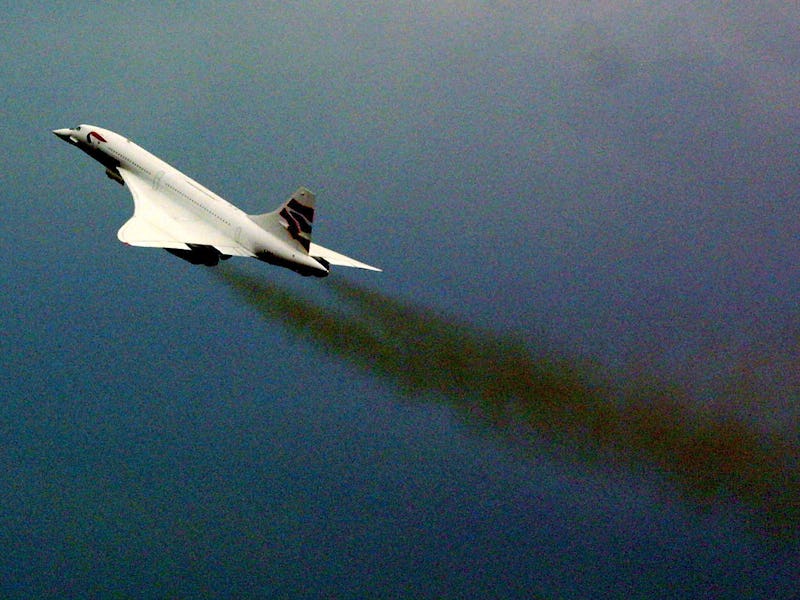Will Supersonic Planes Ever Make Travel Fast Again
When it comes to faster-than-sound air travel, economics have knee-capped innovation.

For 27 years, the Concorde ferried Burberry-clad patricians from London to New York in three hours while they sipped martinis at Mach 2.04. As Air France and British Airways ramped service by Concordes, many had high hopes that supersonic commercial was going to become a norm.
It didn’t.
Instead, a Concorde flight crashed in 2000, the September 11 attacks created a slump in air travel, and maintenance costs became unjustifiable. Although Concordes operated at profit, they raked in a lot less money than conventional flights, and their 30-year-old cabins ceased to look even retro-chi. So Air France and British Airways retired their fleets in 2003. The idea of supersonic travel wasn’t dead, but the planes were effectively extinct.
It’s been twelve years since a Concorde flight, and supersonic travel has yet to return, despite a huge amount of progress in aviation technology, including the advent of hypersonic (5x the speed of sound) fighters. The relevant question no longer concerns whether or not we can make it work; it’s all about whether the airline industry has an incentive to try.
The answers are as bound to history as they are to new technologies.
The Concorde and the Tupolev Tu-144 (the Soviet Union’s answer for supersonic commercial flight which — as fits well with Russian history — had a lot less success) were rife with issues to contend with. Besides being much more difficult to design and construct, the planes needed to be specialized for transporting civilians. This meant reducing excessive noise from takeoff and from sonic booms that occurred when the plane would break the sound barrier. It also meant keeping flights over water in order to not terrify people.
One of the big selling points in the ‘60s for supersonic engines was increased fuel efficiency. Turbofan engines on subsonic planes are less thirsty, which wipes out the Concorde’s advantage. To exacerbate that loss, turbofans can also carry a lot of weight. By the end of the Concorde’s run, a Boeing 747 could carry three times as many passengers while using roughly the same amount of fuel. Bulk beats speed in this particular arena.
And, of course, supersonic flight means much more wear and tear on the plane’s wings, nose, and body. Heavier structures are needed to minimize the stress caused by high winds and temperatures. This means that the empty weight per seat on a Concorde was three times that of a Boeing 747. Again, those numbers aren’t trending in favor of supersonic anything.
All things considered, the Concorde was more of a luxurious novelty than a viable long term strategy for airlines. Keeping those flights in service today would be cheaper, but conventional flights are still profitable enough that mass-market airlines have no particular reason to change their business models.
Furthermore, hypersonic flight, which offers real efficiency, has its own problems not endemic to supersonic flight. The biggest hurdle is the extreme temperature rises caused by the friction of air hitting the craft’s surface at breathtaking speeds. Recent chatter suggests that hypersonic aircraft travel might be sustainable using “scramjets” (supersonic combustion ramjet engines), which allow for airflow through the engine’s combustion chamber and could cool the jet down. These “air-breathing” vehicles could reach speeds as high as Mach 15, but don’t expect them to hit the tarmac at JFK any time soon.
The delay has everything to do with research budgets. In 2012, NASA spent a meager $15 million to study hypersonic travel. The military is much more interested in hypersonic flight, but of course, this is for military purposes. Commercial spaceflight companies like Virgin Galactic are also interested in using hypersonic flight technology for their own vehicles, but their destinations — and ticket prices — are literally out of this world.
Still, Virgin’s extraterrestrial ambitions may represent a glimmer of hope for faster-than-sound travel. The civilian race to space is fueled by egos and by money; it makes sense largely because the wealth gap has given a fair number of people truly and profoundly disposable income. These consumers care more about an experience than they do saving money, a reality that fundamentally changes the economics of travel. Within that market, currently dominated by NetJets and its ilk, a supersonic or hypersonic service might make sense. Jetsetter gonna jetset — they might as well do it in style. A specific carrier could move into this space, but it would almost certainly have to branch off from an existing airline because overhead would be significant.
And, let’s be real, the airline industry has experienced more than its fair share of turbulence, so we’re not talking about a group of execs looking to take risks.
It’ll be at least 15 years and probably much longer than that before anyone gets to enjoy the thrills of a three-hour flight from Paris to Tokyo. But that doesn’t mean it’s never going to happen, just that you might want to continue stockpiling Ambien for a while.